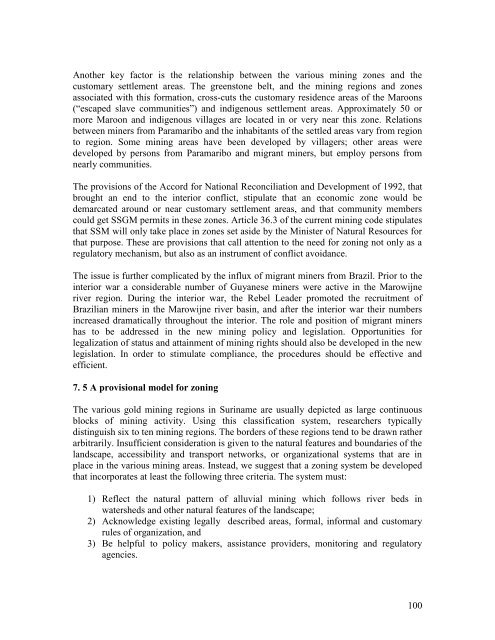SITUATION ANALYSIS OF THE SMALL-SCALE GOLD ... - WWF
SITUATION ANALYSIS OF THE SMALL-SCALE GOLD ... - WWF
SITUATION ANALYSIS OF THE SMALL-SCALE GOLD ... - WWF
Create successful ePaper yourself
Turn your PDF publications into a flip-book with our unique Google optimized e-Paper software.
Another key factor is the relationship between the various mining zones and the<br />
customary settlement areas. The greenstone belt, and the mining regions and zones<br />
associated with this formation, cross-cuts the customary residence areas of the Maroons<br />
(“escaped slave communities”) and indigenous settlement areas. Approximately 50 or<br />
more Maroon and indigenous villages are located in or very near this zone. Relations<br />
between miners from Paramaribo and the inhabitants of the settled areas vary from region<br />
to region. Some mining areas have been developed by villagers; other areas were<br />
developed by persons from Paramaribo and migrant miners, but employ persons from<br />
nearly communities.<br />
The provisions of the Accord for National Reconciliation and Development of 1992, that<br />
brought an end to the interior conflict, stipulate that an economic zone would be<br />
demarcated around or near customary settlement areas, and that community members<br />
could get SSGM permits in these zones. Article 36.3 of the current mining code stipulates<br />
that SSM will only take place in zones set aside by the Minister of Natural Resources for<br />
that purpose. These are provisions that call attention to the need for zoning not only as a<br />
regulatory mechanism, but also as an instrument of conflict avoidance.<br />
The issue is further complicated by the influx of migrant miners from Brazil. Prior to the<br />
interior war a considerable number of Guyanese miners were active in the Marowijne<br />
river region. During the interior war, the Rebel Leader promoted the recruitment of<br />
Brazilian miners in the Marowijne river basin, and after the interior war their numbers<br />
increased dramatically throughout the interior. The role and position of migrant miners<br />
has to be addressed in the new mining policy and legislation. Opportunities for<br />
legalization of status and attainment of mining rights should also be developed in the new<br />
legislation. In order to stimulate compliance, the procedures should be effective and<br />
efficient.<br />
7. 5 A provisional model for zoning<br />
The various gold mining regions in Suriname are usually depicted as large continuous<br />
blocks of mining activity. Using this classification system, researchers typically<br />
distinguish six to ten mining regions. The borders of these regions tend to be drawn rather<br />
arbitrarily. Insufficient consideration is given to the natural features and boundaries of the<br />
landscape, accessibility and transport networks, or organizational systems that are in<br />
place in the various mining areas. Instead, we suggest that a zoning system be developed<br />
that incorporates at least the following three criteria. The system must:<br />
1) Reflect the natural pattern of alluvial mining which follows river beds in<br />
watersheds and other natural features of the landscape;<br />
2) Acknowledge existing legally described areas, formal, informal and customary<br />
rules of organization, and<br />
3) Be helpful to policy makers, assistance providers, monitoring and regulatory<br />
agencies.<br />
100
















